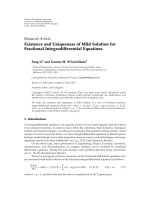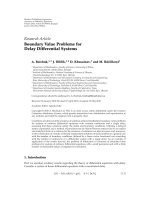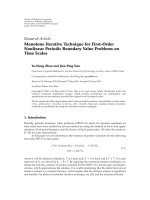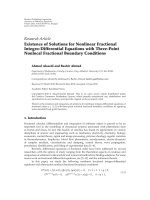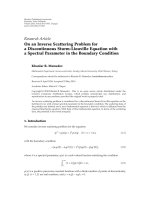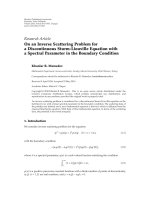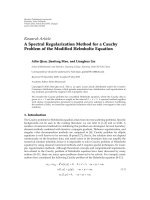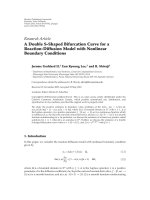Báo cáo sinh học: " Research Article Quenching for a Reaction-Diffusion System with Coupled Inner Singular Absorption Terms Shouming Zhou and Chunlai Mu" pptx
Bạn đang xem bản rút gọn của tài liệu. Xem và tải ngay bản đầy đủ của tài liệu tại đây (834.31 KB, 15 trang )
Hindawi Publishing Corporation
Boundary Value Problems
Volume 2010, Article ID 797182, 15 pages
doi:10.1155/2010/797182
Research Article
Quenching for a Reaction-Diffusion System with
Coupled Inner Singular Absorption Terms
Shouming Zhou and Chunlai Mu
College of Mathematics and Statistics, Chongqing University, Chongqing 400044, China
Correspondence should be addressed to Shouming Zhou,
Received 13 May 2010; Accepted 5 July 2010
Academic Editor: Claudianoro. Alves
Copyright q 2010 S. Zhou and C. Mu. This is an open access article distributed under the Creative
Commons Attribution License, which permits unrestricted use, distribution, and reproduction in
any medium, provided the original work is properly cited.
we devote to investigate the quenching phenomenon for a reaction-diffusion system with coupled
singular absorption terms, u
t
Δu − u
−p
1
v
−q
1
, v
t
Δv − u
−p
2
v
−q
2
. The solutions of the system
quenches in finite time for any initial data are obtained, and the blow-up of time derivatives at
the quenching point is verified. Moreover, under appropriate hypotheses, the criteria to identify
the simultaneous and nonsimultaneous quenching are found, and the four kinds of quenching
rates for different nonlinear exponent regions are given. Finally, some numerical experiments are
performed, which illustrate our results.
1. Introduction
This paper deals with the following nonlinear parabolic equations with null Neumann
boundary conditions:
u
t
Δu − u
−p
1
v
−q
1
,v
t
Δv − u
−p
2
v
−q
2
,
x, t
∈ Ω ×
0,T
,
∂u
∂n
∂v
∂n
0,
x, t
∈ ∂Ω ×
0,T
,
u
x, 0
u
0
x
,v
x, 0
v
0
x
,x∈
Ω,
1.1
where p
i
,q
i
≥ 0fori 1, 2, Ω ⊂ R
n
is a bounded domain with smooth boundary, the initial
data u
0
and v
0
are positive, smooth, and compatible with the boundary data.
Because of the singular nonlinearity inner absorption terms of 1.1, the so-called
finite-time quenching may occur for the model. We say that the solution u, v of the problem
2 Boundary Value Problems
1.1 quenches, if there exists a time t T<∞ T denotes the quenching time, x denotes
quenching point, such that
lim
t →T
−
inf min
min
Ω
u
x, t
, min
Ω
v
x, t
0.
1.2
For a quenching solution u, v of 1.1, the inf norm of one of the components must
tend to 0 as t tends to the quenching time T. The case when u quenches and v remains
bounded from zero is called non-simultaneous quenching. We will call the case, when both
components u and v quench at the same time, as simultaneous quenching. The purpose of
this paper is to find a criteria to identify simultaneous and non-simultaneous quenching for
1.1 and then establish quenching rates for the different cases.
In order to motivate the main results for system 1.1, we recall some classical results
for the related system. de Pablo et al., firstly distinguished non-simultaneous quenching from
simultaneous one in 1. They considered a heat system coupled via inner absorptions as
follows:
u
t
u
xx
− v
−p
,v
t
v
xx
− u
−q
,
x, t
∈
0, 1
×
0,T
,
u
x
0,t
u
x
1,t
v
x
0,t
v
x
1,t
0,t∈
0,T
,
u
x, 0
u
0
x
,v
x, 0
v
0
x
,x∈
0, 1
.
1.3
Recently, Zheng and Wang deduced problem 1.3 to n-dimensional with positive Dirichlet
boundary condition in 2. Then, Zhou et al. have given a natural continuation for problem
1.3 beyond quenching time T for the case of non-simultaneous quenching in 3.
Replacing the coupled inner absorptions in 1.1 by the coupled boundary fluxes, one
gets
u
t
u
xx
,v
t
v
xx
,
x, t
∈
0, 1
×
0,T
,
u
x
0,t
u
−p
1
v
−q
1
0,t
,v
x
0,t
u
−p
2
v
−q
2
0,t
,t∈
0,T
,
u
x
1,t
0,v
x
1,t
0,t∈
0,T
,
u
x, 0
u
0
x
,v
x, 0
v
0
x
,x∈
0, 1
.
1.4
Recently, the simultaneous and non-simultaneous quenching for problem 1.4, and what is
related to it, was studied by many authors see 4–7 and references therein.
In order to investigate the problem 1.1, it is necessary to recall the blow-up problem
of the following reaction-diffusion system:
u
t
Δu u
p
1
v
q
1
,v
t
Δv u
p
2
v
q
2
,
x, t
∈ Ω ×
0,T
,
u v 0,
x, t
∈ ∂Ω ×
0,T
,
u
x, 0
u
0
x
,v
x, 0
v
0
x
,x∈
Ω,
1.5
Boundary Value Problems 3
with positive powers p
i
,q
i
i 1, 2 has been extensively studied by many authors for
various problems such as global existence and finite time blow-up, Fujita exponents, non-
simultaneous and simultaneous blow-up, and blow-up rates, see 8–10 and references
therein. However, unlike the blow-up problem, there are less papers consider the weakly
coupled quenching problem like 1.1,differently from the generally considered, there are
two additional singular factors, namely, −v
−p
and −u
−q
for the inner absorptions of u and
v, respectively. In this paper, we will show real contributions of the two additional singular
factors to the quenching behavior of solutions. Our main results are stated as follows.
Theorem 1.1. If p
1
,p
2
,q
1
,q
2
≥ 0 and p
1
p
2
q
1
q
2
/
0, then the solution of the system 1.1
quenches in finite time for every initial data.
On the other hand, some authors understand quenching as blow-up of time
derivatives while the solution itself remains bounded see 11–13. In present paper, we
assume that the initial data satisfy
Δu
0
− u
−p
1
0
v
−q
1
0
< 0, Δv
0
− u
−p
2
0
v
−q
2
0
< 0,x∈ Ω.
1.6
Theorem 1.2. Let ΩB
R
{x ∈ R
N
: |x| <R} and the radial initial function satisfies 1.6,then
u
t
,v
t
blows up in finite time.
Next, we characterize the ranges of parameters to distinguish simultaneous and non-
simultaneous quenching. In order to simplify our work, we deal with the radial solutions of
1.1 with ΩB
R
{x ∈ R
n
: |x| <R}, and the radial increasing initial data satisfies 1.6.
Thus we, see that x 0 is the only quenching point see 2, 14. Without loss of generality,
we only consider the non-simultaneous quenching with u remaining strictly positive, and our
main results are stated as follows.
Theorem 1.3. If p
2
≥ p
1
1 and q
1
≥ q
2
1, then any quenching in 1.1 must be simultaneous.
Theorem 1.4. If p
2
≥ p
1
1 and q
1
<q
2
1, then any quenching in 1.1 is non-simultaneous with
u being strictly positive.
Theorem 1.5. If p
2
<p
1
1 and q
1
<q
2
1, then both simultaneous and non-simultaneous quenching
may occur in 1.1 depending on the initial data.
Remark 1.6. In particular, if we choose p
1
q
2
0,q
1
,p
2
> 0, then we obtain that the ranges
of parameters to distinguish simultaneous and non-simultaneous quenching coincide with
the problem 1.3see 1, 2. Moreover, this criteria to identify the simultaneous and non-
simultaneous quenching is the same with the problem 1.4 which coupled boundary fluxes
see 6. This situation also happens for the blow-up problem see 8, 10, 15.
Next, we deal with quenching rates. To state our results more conveniently, we
introduce the notation f ∼ g which means that there exist two finite positive constants c
1
,c
2
such that c
1
g ≤ f ≤ c
2
g, and the two parameters α and β verifying
p
1
1 q
1
p
2
q
2
1
α
β
1
1
, 1.7
4 Boundary Value Problems
or equivalently,
α
q
1
− q
2
− 1
p
2
q
1
−
p
1
1
q
2
1
,β
p
2
− p
1
− 1
p
2
q
1
−
p
1
1
q
2
1
.
1.8
In terms of parameters α and β, the quenching rates of problem 1.1 can be shown as
follow.
Theorem 1.7. If quenching is non-simultaneous and, for instance, v is the quenching variable, then
v0,t ∼ T − t
1/q
2
1
as t → T.
Theorem 1.8. If quenching is simultaneous, then for t close to T, we have
i u0,t ∼ T −t
α
,v0,t ∼ T −t
β
for p
2
<p
1
1, q
1
<q
2
1 or p
2
>p
1
1,q
1
>q
2
1;
ii u0,t,v0,t ∼ T − t
p
1
q
1
1
for p
2
p
1
1 and q
1
q
2
1;
iii u0,t ∼ T − t
1/p
1
1
|logT − s|
−q
1
/q
2
−q
1
1p
1
1
,v0,t ∼|logT − t|
1/q
2
−q
1
1
for
p
2
p
1
1 and q
1
>q
2
1.
The plan of this paper is organized as follows. In Section 2, we distinguish non-
simultaneous quenching from simultaneous one. The four kinds of non-simultaneous and
simultaneous quenching rates for different nonlinear exponent regions are given in Section 3.
In the Section 4, we perform some numerical experiments which illustrate our results.
2. Simultaneous and Non-Simultaneous Quenching
Proof of Theorem 1.1. Assume that u, v is the classical solution of 1.1 with the maximal
existence time T. The maximum principle implies 0 <u≤ M : u
0
x
L
∞
and 0 <v≤
N : v
0
x
L
∞
in Ω × 0,T.LetFt
Ω
ux, tdx, Gt
Ω
vx, tdx, t ∈ 0,T. Hence,
integrating 1.1 in space and using Green’s formula, we have
F
t
Ω
Δu − u
−p
1
v
−q
1
dx ≤−M
−p
1
N
−q
1
,G
t
≤−M
−p
2
N
−q
2
.
2.1
Consequently,
F
t
≤
|
Ω
|
M − M
−p
1
N
−q
1
t, G
t
≤
|
Ω
|
N − M
−p
2
N
−q
2
t. 2.2
Thus, the solution of the problem 1.1 quenches in finite time. The prove of Theorem 1.1 is
complete.
In order to prove Theorem 1.2, we need the following Lemma.
Lemma 2.1. Assume that ΩB
R
{x ∈ R
N
: |x| <R} and the radial nondecreasing initial data
satisfy 1.6, then there exists a small δ>0 such that
u
t
< −δu
−p
1
v
−q
1
,v
t
< −δu
−p
2
v
−q
2
,
x, t
∈ Ω ×
0,T
. 2.3
Boundary Value Problems 5
Proof. Let I u
t
δu
−p
1
v
−q
1
,J v
t
δu
−p
2
v
−q
2
, x, t ∈ Ω × 0,T.Thus,
I
t
− ΔI p
1
u
−p
1
−1
v
−q
1
I q
1
u
−p
1
v
−q
1
−1
J − δp
1
p
1
1
u
−p
1
−2
v
−q
1
|
∇u
|
2
− δq
1
q
1
1
u
−p
1
v
−q
1
−2
|
∇v
|
2
− 2δp
1
q
1
u
−p
1
−1
v
−q
1
−1
∇u ·∇v.
2.4
Since u and v are radial and nondecreasing in |x|, we have ∇u ·∇v u
r
v
r
≥ 0. A similar
computation holds for J, and we obtain
I
t
− ΔI ≤ p
1
u
−p
1
−1
v
−q
1
I q
1
u
−p
1
v
−q
1
−1
J,
x, t
∈ Ω ×
0,T
,
J
t
− ΔJ ≤ p
2
u
−p
2
−1
v
−q
2
I q
2
u
−p
2
v
−q
2
−1
J,
x, t
∈ Ω ×
0,T
,
2.5
with boundary conditions
∂I
∂n
∂J
∂n
0,
x, t
∈ ∂Ω ×
0,T
.
2.6
From 1.6, it is easy to deduce u
t
x, 0,v
t
x, 0 ≤−θ<0inΩsee 13, 14. Choosing δ small
enough, we have that the initial data verifying
I
x, 0
u
t
x, 0
δu
−p
1
v
−q
1
x, 0
≤ 0,x∈ ∂Ω,
J
x, 0
v
t
x, 0
δu
−p
2
v
−q
2
x, 0
≤ 0,x∈ ∂Ω.
2.7
Hence, by the comparison result, we derive that
I
x, t
u
t
x, t
δu
−p
1
v
−q
1
x, t
≤ 0,
J
x, t
v
t
x, t
δu
−p
2
v
−q
2
x, t
≤ 0,
x, t
∈ Ω ×
0,T
. 2.8
This proves Lemma 2.1.
Proof of Theorem 1.2. This theorem is the direct result of Theorem 1.1 and Lemma 2.1.
Next, we characterize the ranges of parameters to distinguish simultaneous and non-
simultaneous quenching. By the hypothesis on the initial data, we obtain min
x∈B
R
ux, t
u0,t, min
x∈B
R
vx, tv0,t and u
t
0,t ≥−u
−p
1
v
−p
1
0,t,v
t
0,t ≥−u
−p
2
v
−p
2
0,t for t ∈
0,Tsee 2, 14. We collect the estimates of the time derivatives obtained before. Clearly,
the only quenching point is x 0 see 2, we only care for the original point,
−u
−p
1
v
−p
1
0,t
≤ u
t
0,t
≤−δu
−p
1
v
−p
1
0,t
,t∈
0,T
, 2.9
−u
−p
2
v
−p
2
0,t
≤ v
t
0,t
≤−δu
−p
2
v
−p
2
0,t
,t∈
0,T
. 2.10
Proof of Theorem 1.3. We argue by contradiction. Assume that there exists a>0 such
that u ≥ a on
B
R
× 0,T and v quenching at the time T. Through 2.10, we have
6 Boundary Value Problems
v
t
0,t ≥−u
−p
2
v
−p
2
≥−a
−p
2
v
−p
2
, integrating from t to T we get vt ≤ CT − t
1/q
2
1
.
Together with 2.9 we have u
t
0,t ≤−CT − t
−q
1
/q
2
1
. Integrating in 0,T,we
obtain
C
T
0
T − t
−q
1
/q
2
1
dt ≤ u
0, 0
− u
0,T
.
2.11
If q
1
/q
2
1 ≥ 1, we have the left hand of the above inequality diverged. So, we get a
contradiction. The proof of Theorem 1.3 is finished.
Proof of Theorem 1.4. First, assume that p
2
>p
1
1andq
1
<q
2
1. Combining 2.9 with 2.10,
we get
1
δ
v
q
2
−q
1
v
t
0,t
≤ u
p
1
−p
2
u
t
0,t
≤ δv
q
2
−q
1
v
t
0,t
.
2.12
Since q
1
− q
2
< 1 <p
2
− p
1
, integrating the first inequality in the 2.12 from 0 to t, we have
v
q
2
−q
1
1
0,t
≤ C
1
− C
2
u
p
1
−p
2
1
0,t
,
2.13
where C
1
,C
2
are positive constants, the above inequality requires that u remains positive up
to the quenching time. The case q
1
− q
2
< 1 ≤ p
2
− p
1
can be treated in an analogous way. The
proof of Theorem 1.4 is complete.
Proof of Theorem 1.5. If p
1
p
2
p
3
p
4
1 and the initial data u
0
xv
0
x on B
R
, thus, it is
easy to see that for problem 1.1 simultaneous quenching occurs.
On the other hand, we want to choose v
0
small in order that the quenching time T
through Theorem 1.1,wegetT ≤ min|Ω|M
p
1
1
N
q
1
, |Ω| M
p
2
N
q
2
1
be so small that u does
not have time to vanish.
Let u
0
> 0 be fixed. From u
t
,v
t
≤−θ in Ω × 0,T,weobtain
u
0,t
≥ θ
T − t
,v
0,t
≥ θ
T − t
,t∈
0,T
. 2.14
Together with the estimate 2.12,weget
v
t
0,t
≥−u
−p
2
v
−p
2
0,t
≥−θ
−p
2
T − t
−p
2
v
−p
2
0,t
. 2.15
Integrating in 0,t,weobtain
1
q
2
1
v
q
2
1
0,t
≥
1
q
2
1
v
q
2
1
0, 0
− θ
−p
2
t
0
T − s
−p
2
ds
≥
1
q
2
1
v
q
2
1
0, 0
− θ
−p
2
T
0
T − s
−p
2
ds
≥
1
q
2
1
v
q
2
1
0, 0
−
θ
−p
2
1 − p
2
T
1−p
2
.
2.16
Boundary Value Problems 7
It is easy to see that the last term of the above inequality is strictly positive, if T is small
enough and p
2
< 1, therefore, we prove that, under the condition p
2
<p
1
1andq
1
<q
2
1,
for the solution of 1.1 non-simultaneous quenching may occur. The proof of Theorem 1.5 is
complete.
3. Quenching Rates
In this section, we deal with the all possible quenching rates in model 1.1.
Proof of Theorem 1.7. Under the condition of Theorem 1.7, it holds that a ≤ u0,t ≤ M.By
2.10, we have
−a
−p
2
v
−p
2
0,t
≤ v
t
0,t
≤−δM
−p
2
v
−p
2
0,t
,t∈
0,T
. 3.1
Thus,
v
0,t
∼
T − t
1/q
2
1
as t −→ T.
3.2
The proof of Theorem 1.7 is complete.
Proof of Theorem 1.8. i Assume that the quenching of problem 1.1 is simultaneous with
p
2
>p
1
1,q
1
>q
2
1, integrating 2.12 yields
c
1
v
q
2
−q
1
1
0,t
− v
q
2
−q
1
1
0
0
≤ c
2
u
p
1
−p
2
1
0,t
− u
p
1
−p
2
1
0
0
, 3.3
where c
1
1/δq
2
− q
1
1,c
2
1/p
1
− p
2
1. Since we assume that u, v quench at T,we
have v
q
2
−q
1
1
0,t →∞,u
p
1
−p
2
1
→∞as t → T.
On the other hand, from q
2
− q
1
1 < 0andp
1
− p
2
1 < 0, we get, a positive constant
C
1
such that
v
q
2
−q
1
1
0,t
≥ C
1
u
p
1
−p
2
1
0,t
, as t −→ T.
3.4
Similarly, we can show that there exists a positive constant C
2
such that
u
p
1
−p
2
1
0,t
≥ C
2
v
q
2
−q
1
1
0,t
, as t −→ T.
3.5
Consequently,
u
p
1
−p
2
1
0,t
∼ v
q
2
−q
1
1
0,t
, as t −→ T.
3.6
Recalling the estimates 2.9 and 2.10,weobtain
u
t
0,t
∼−u
−q
1
p
1
−p
2
1/q
2
−q
1
1−p
1
,v
t
0,t
∼−v
−p
2
q
2
−q
1
1/p
1
−p
2
1−q
2
.
3.7
8 Boundary Value Problems
Integrating from t to T,weget
u
0,t
∼
T − t
α
,v
0,t
∼
T − t
β
, as t −→ T.
3.8
If p
2
<p
1
1andq
1
<q
2
1, we deduce the quenching rate by a bootstrap argument. First,
by 2.9,wegetu
t
0,t ≤−δu
−p
1
N
−q
1
, it follows that u ≥ cT − t
1/p
1
1
. Employing 2.10,
we get v
t
0,t ≥−u
−p
2
v
−q
2
≥−cT − t
−p
2
/p
1
1
v
−q
2
,thatis,v0,t ≤ cT − t
p
1
−p
2
1/q
2
1p
1
1
.
Repeating this procedure, we obtain u0,t ≥ cT − t
α
n
, v0,t ≥ cT − t
β
n
, where α
n
,β
n
satisfy
p
1
1
α
n1
1 − q
1
β
n
,
q
2
1
β
n1
1 − p
2
α
n
,
α
0
1
p
1
1
,β
0
p
1
− p
2
1
q
2
1
p
1
1
.
3.9
One can check that α
n
→ α, β
n
→ β α, β define by 1.8, and the all positive constants c
are bounded. Therefore, passing to the limit, we get u0,t ≥ cT −t
α
,v0,t ≥ cT −t
β
.The
reverse inequalities can be obtained in the same way.
ii If p
2
p
1
1andq
1
q
2
1, we have p
1
q
1
p
2
q
2
. It is easy to see that
u0,t ∼ v0,t as t → T,from2.9 and 2.10,weobtain
u
0,t
,v
0,t
∼
T − t
p
1
q
1
1
, as t −→ T.
3.10
iii If p
2
p
1
1andq
1
>q
2
1, from 2.9,weget
u
0,t
∼ exp
−cv
q
2
−q
1
1
0,t
. 3.11
Recalling the estimate 2.10,weget
v
t
0,t
∼−exp
p
2
cv
q
2
−q
1
1
v
−q
2
, 3.12
that is,
0
v
0,t
exp
−p
2
cy
q
2
−q
1
1
y
q
2
dy ∼−
T − t
.
3.13
Let p
2
cy
q
2
−q
1
1
sws, we have
∞
p
2
cv
q
2
−q
1
1
0,t
cw
q
1
/q
2
−q
1
1
e
−w
dw ∼
T − t
.
3.14
Boundary Value Problems 9
It is known that the incomplete Gamma function Γa, z
∞
z
w
a−1
e
−w
dw satisfies Γa, z ∼
z
a−1
e
−z
for z →∞.Witha − 1 q
1
/q
2
− q
1
1,weobtain
T − t
∼ v
q
2
exp
−cp
2
v
q
2
−q
1
1
, 3.15
and hence,
v
0,t
∼
logT − t
1/q
2
−q
1
1
.
3.16
Next, we deduce the behaviour for u. Combining with 2.9 and 3.16, we have
u
p
1
u
t
0,t
∼−
logT − t
−q
1
/q
2
−q
1
1
.
3.17
Integrating from t to T,
u
p
1
1
0,t
∼
T
t
logT − s
−q
1
/q
2
−q
1
1
ds.
3.18
Setting logT − s−z,weget
u
p
1
1
0,t
∼
∞
−logT−t
z
−q
1
/q
2
−q
1
1
e
−z
ds.
3.19
For the incomplete Gamma function Γa, −logT −t with a−1 −q
1
/q
2
−q
1
1,weobtain
u
0,t
∼
T − t
1/p
1
1
logT − s
−q
1
/q
2
−q
1
1p
1
1
.
3.20
The proof of Theorem 1.8 is complete.
4. Numerical Experiments
In this section, we perform some numerical experiments, which illustrate our results. Now
we introduce the numerical scheme for the space discretization, we discretize applying linear
finite elements with mass lumping in a uniform mesh for the space variable and keeping t
continuous, it is well known that this discretization in space coincides with the classic central
finite difference second-order scheme, see 16, Mass lumping is widely used in parabolic
problems with blow-up and quenching, see, e.g., 17, 18.
Let us consider the uniform partition of size h of the interval −L, L, x
i
ih, h
L/N, i 1, ,N, and its associated standard piecewise linear finite element space V
h
.
10 Boundary Value Problems
0
0.1
0.2
0.3
0.4
0.5
0.6
0.7
0.8
The value of ux, T
−2 −1.5 −1 −0.50 0.511.52
Space p
1
0.5,q
2
0.6,q
1
p
2
2
ux, T
vx, T
Figure 1: The value of the solution at the quenching time T 0.132431.
0
0.1
0.2
0.3
0.4
0.5
0.6
0.7
0.8
0.9
The value of u0,t
00.02 0.04 0.06 0.08 0.10.12 0.14
Time the quenching time T 0.132431
u0,t
v0,t
Figure 2: Evolution at the point x
0
0 of the solution p
1
0.5,q
2
0.6,q
1
p
2
2.
The semidiscrete approximation u
h
t,v
h
t ∈ V
h
obtained by the finite element method
with mass lumping is defined as
L
−L
u
h
t
w
I
dx
L
−L
u
h
x
w
x
dx −
L
−L
v
h
−p
w
I
dx, ∀w ∈ V
h
, ∀t ∈
0,T
,
L
−L
v
h
t
w
I
dx
L
−L
v
h
x
w
x
dx −
L
−L
u
h
−q
w
I
dx, ∀w ∈ V
h
, ∀t ∈
0,T
,
4.1
Boundary Value Problems 11
0
0.1
0.2
0.3
0.4
0.5
0.6
0.7
0.8
0.9
The value of ux, T
−2 −1.5 −1 −0.50 0.511.52
Space p
1
q
2
1,q
1
p
2
3
ux, T
vx, T
Figure 3: The value of the solution at the quenching time T 0.0660034.
0
0.1
0.2
0.3
0.4
0.5
0.6
0.7
0.8
0.9
The value of u0,t
00.01 0.02 0.03 0.04 0.05 0.06 0.07
Time the quenching time T 0.0660034
u0,t
v0,t
Figure 4: Evolution at the point x
0
0 of the solution p
1
q
2
1,q
1
p
2
3.
where the superindex I denotes the Lagrange interpolation.
We denote with Ut,Vt u
1
, ,u
N
, v
1
, ,v
N
the values of the numerical
approximation at the nodes x
i
ih and the time t.Thus,
u
h
x, t
,v
h
x, t
N
k1
u
k
t
ψ
x
,
N
k1
v
k
t
ψ
x
,
4.2
12 Boundary Value Problems
0
0.1
0.2
0.3
0.4
0.5
0.6
0.7
0.8
0.9
The value of u0,t
00.02 0.04 0.06 0.08 0.10.12 0.14 0.16 0.18
Time the quenching time T 0.170478
u0,t
v0,t
Figure 5: Evolution at the point x
0
0 of the solution p
1
q
1
q
2
1,p
2
3.
0
0.1
0.2
0.3
0.4
0.5
0.6
0.7
0.8
0.9
The value of u0,t
00.01 0.02 0.03 0.04 0.05 0.06 0.07 0.08
Time the quenching time T 0.0798854
u0,t
v0,t
Figure 6: Evolution at the point x
0
0 of the solution p
1
0.6,q
1
0.5,p
2
2,q
2
1.
where {ψ
k
} is the standard base of V
h
. Then Ut,vt satisfies the following ODE system:
MU
t
−AU
t
− MU
−p
1
V
−q
1
t
,
MV
t
−AV
t
− MU
−p
2
V
−q
2
t
,
U
0
,V
0
φ
I
,ϕ
I
,
4.3
Boundary Value Problems 13
0
0.1
0.2
0.3
0.4
0.5
0.6
0.7
0.8
0.9
The value of u0,t
00.02 0.04 0.06 0.08 0.10.12
Time the quenching time T 0.102117
u0,t
v0,t
Figure 7: Evolution at the point x
0
0 of the solution p
1
q
1
p
2
q
2
1.
0
0.1
0.2
0.3
0.4
0.5
0.6
0.7
0.8
0.9
The value of u0,t
00.05 0.10.15 0.20.25 0.30.35
Time the quenching time T 0.254578
u0,t
v0,t
Figure 8: Evolution at the point x
0
0 of the solution p
1
q
1
p
2
q
2
1.
where M is the mass matrix obtained with lumping, A is the stiffness matrix, and φ
I
,ϕ
I
is
the Lagrange interpolation of the initial datum φx,ϕx.
We take Ω−2, 2 and −2 x
1
< ···<x
N
2, 0 t
1
< ···<t
M
T. Writing the
system 4.3 explicitly, we get the following ODE system:
14 Boundary Value Problems
δ
t
u
x
1
,t
j
2
h
2
u
x
2
,t
j
− u
x
1
,t
j
− u
−p
1
v
−q
1
x
1
,t
j
, 1 ≤ j ≤ M,
δ
t
v
x
1
,t
j
2
h
2
v
x
2
,t
j
− v
x
1
,t
j
− u
−p
2
v
−q
2
x
1
,t
j
, 1 ≤ j ≤ M,
δ
t
u
x
i
,t
j
u
x
i1
,t
j
− 2u
x
i
,t
j
u
x
i−1
,t
j
h
2
− u
−p
1
v
−q
1
x
i
,t
j
,
1 ≤ i ≤ N − 1, 1 ≤ j ≤ M,
δ
t
v
x
i
,t
j
v
x
i1
,t
j
− 2v
x
i
,t
j
v
x
i−1
,t
j
h
2
− u
−p
2
v
−q
2
x
i
,t
j
,
1 ≤ i ≤ N − 1, 1 ≤ j ≤ M,
δ
t
u
x
N
,t
j
2
h
2
u
x
N−1
,t
j
− u
x
N
,t
j
− u
−p
1
v
−q
1
x
N
,t
j
, 1 ≤ j ≤ M,
δ
t
v
x
N
,t
j
2
h
2
v
x
N−1
,t
j
− v
x
N
,t
j
− u
−p
2
v
−q
2
x
N
,t
j
, 1 ≤ j ≤ M,
u
x
i
,t
1
u
0
ih
,v
x
i
,t
1
v
0
ih
, 1 ≤ i ≤ N,
4.4
where δ
t
vx
i
,t
j
ux
i
,t
j1
/Δt
j
and h 0.01. In order to show the evolution in time of a
numerical solution, we chose Δt
j
λU
j
, U
j
min
1≤i≤N
ux
i
,t
j
,and0<λ<1 which will be
choose later.
First, we consider the case p
1
0.5,q
2
0.6,p
2
q
1
2, and the initial data u
0
1 − 1/10 sinπ/4s 2,v
0
1 − 3/10 sinπ/4s 2, We observe that the solutions
of 1.1 quenching only at the origin, if the symmetric initial data with a unique minimum at
x 0 see Figure 1, and the quenching is simultaneous see Figure 2; If we take p
2
q
1
3,p
1
q
2
1, and the same initial data see Figures 3 and 4, then we obtain the results
which accords with Theorem 1.3.
Next, we take p
1
q
1
q
2
1,p
2
3 with the same initial data u
0
xφs
1 − 1/10 sinπ/4s 2. In this case the quenching in 1.1 is non-simultaneous with u
being strictly positive see Figure 5; If we choose p
1
0.6,q
1
0.5,p
2
2, and q
2
1with
the initial data u
0
1−1/10 sinπ/4s2,v
0
1−1/2 sinπ/4s2 see Figure 6,
then we can see that our results coincide with Theorem 1.4.
Finally, we choose p
1
q
1
p
2
q
2
1InFigure 7, we take the initial data u
0
1 − 1/10 sinπ/4s 2,v
0
1 − 1/2 sinπ/4s 2,andinFigure 8 we take the
different initial data both equal to 1 − 1/10 sinπ/4s 2, we can see that both non-
simultaneous quenching and simultaneous quenching may occur in 1.1, depending on the
initial data.
Acknowledgments
This work is supported in part by NSF of China 10771226 and in part by Innovative Talent
Training Project, the Third Stage of “211 Project”, Chongqing University, Project no.: S-09110.
Boundary Value Problems 15
References
1 A. de Pablo, F. Quir
´
os, and J. D. Rossi, “Nonsimultaneous quenching,” Applied Mathematics Letters,
vol. 15, no. 3, pp. 265–269, 2002.
2 S. Zheng and W. Wang, “Non-simultaneous versus simultaneous quenching in a coupled nonlinear
parabolic system,” Nonlinear Analysis: Theory, Methods & Applications, vol. 69, no. 7, pp. 2274–2285,
2008.
3 J. Zhou, Y. He, and C. Mu, “Incomplete quenching of heat equations with absorption,” Applicable
Analysis, vol. 87, no. 5, pp. 523–529, 2008.
4 R. Ferreira, A. de Pablo, F. Quir
´
os, and J. D. Rossi, “Non-simultaneous quenching in a system of heat
equations coupled at the boundary,” Zeitschrift f
¨
ur Angewandte Mathematik und Physik, vol. 57, no. 4,
pp. 586–594, 2006.
5 R. Ferreira, A. de Pablo, M. P
´
erez-Llanos, and J. D. Rossi, “Incomplete quenching in a system of heat
equations coupled at the boundary,” Journal of Mathematical Analysis and Applications, vol. 346, no. 1,
pp. 145–154, 2008.
6 R. Ji and S. Zheng, “Quenching behavior of solutions to heat equations with coupled boundary
singularities,” Applied Mathematics and Computation, vol. 206, no. 1, pp. 403–412, 2008.
7 S. Zheng and X. F. Song, “Quenching rates for heat equations with coupled singular nonlinear
boundary flux,” Science in China. Series A, vol. 51, no. 9, pp. 1631–1643, 2008.
8 M. Escobedo and H. A. Levine, “Critical blowup and global existence numbers for a weakly coupled
system of reaction-diffusion equations,” Archive for Rational Mechanics and Analysis, vol. 129, no. 1, pp.
47–100, 1995.
9 J S. Guo, S. Sasayama, and C J. Wang, “Blowup rate estimate for a system of semilinear parabolic
equations,” Communications on Pure and Applied Analysis, vol. 8, no. 2, pp. 711–718, 2009.
10 M. Wang, “Blow-up rate estimates for semilinear parabolic systems,” Journal of Differential Equations,
vol. 170, no. 2, pp. 317–324, 2001.
11 C. Y. Chan, “Recent advances in quenching phenomena,” in Proceedings of Dynamic Systems and
Applications, vol. 2, pp. 107–113, Atlanta, Ga, USA, 1996.
12 H. Kawarada, “On solutions of initial-boundary problem for u
t
u
xx
1/1 −u,” Publications of the
Research Institute for Mathematical Sciences, vol. 10, no. 3, pp. 729–736, 1975.
13 T. Salin, “On quenching with logarithmic singularity,” Nonlinear Analysis: Theory, Methods &
Applications, vol. 52, no. 1, pp. 261–289, 2003.
14 C. Mu, S. Zhou, and D. Liu, “Quenching for a reaction-diffusion system with logarithmic singularity,”
Nonlinear Analysis: Theory, Methods & Applications, vol. 71, no. 11, pp. 5599–5605, 2009.
15 J. P. Pinasco and J. D. Rossi, “Simultaneous versus non-simultaneous blow-up,” New Zealand Journal
of Mathematics, vol. 29, no. 1, pp. 55–59, 2000.
16 P. G . C i a r l e t , The Finite Element Method for Elliptic Problems, Studies in Mathematics and Its
Applications, North-Holland, Amsterdam, The Netherlands, 1978.
17 R. Ferreira, “Numerical quenching for the semilinear heat equation with a singular absorption,”
Journal of Computational and Applied Mathematics, vol. 228, no. 1, pp. 92–103, 2009.
18 P. Groisman, F. Quir
´
os, and J. D. Rossi, “Non-simultaneous blow-up in a numerical approximation of
a parabolic system,” Computational & Applied Mathematics, vol. 21, no. 3, pp. 813–831, 2002.

